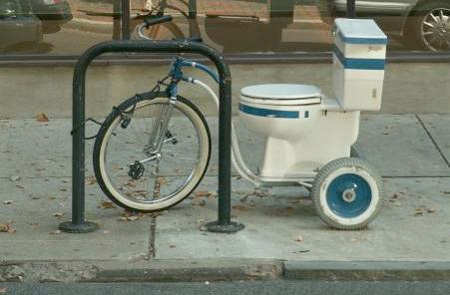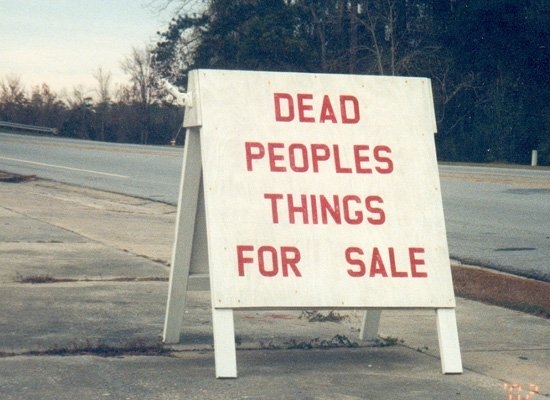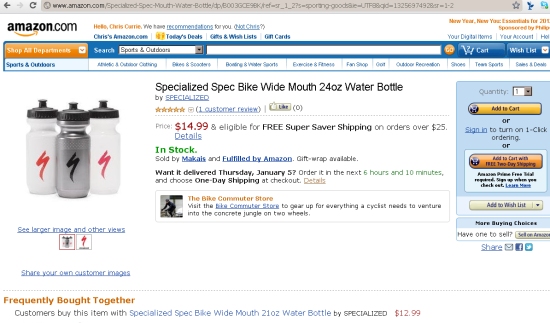
Friday, and it seems Specialized has taken a break from dastardly deeds long enough for the world of bicycles and commerce to briefly focus on other things. I, for one, am moving quickly, before they drive a bus of puppies into a lake. So this post isn’t just about Specialized; it’s about actually being specialized.
The point my last few rants have been building up to is this: little guys can compete. Even against corporate giants within the same market. Amazon included. More specifically, brick and mortar bike shops can compete against online retailers. Online.
The elephant in the room for me as I was reading that letter from Mike Sinyard was just how repressed these dealers really were. The impression was that the Internet is this giant shadow that’s slowly passing over all of them, and all they can do is hoot and throw sticks at the darkness. Usually, it’s so fundamentally depressing to see this reaction that I’m hard-pressed to even address it, but this fear of change has been rampant in the bike industry for years now, and I think it’s time independent dealers started using the opposable thumb Darwin gave them and using tools. Instead of taking the isolationist approach that Sinyard advocates in his letter, why don’t more dealers sell products online?
Here’s why this isn’t such a crazy idea.
I’m not talking about dropping a 20,000 item catalog on your site and trying to go head to head with major e-commerce retailers. I’m talking about small steps to drive top line growth and sure up your reputation as a great bike shop. The technology and capability has never been easier to put an e-commerce application in place, and, if you can manage to use Quickbooks, you can safely and securely sell products to people all around the world. Furthermore, you–yes you, little bike shop–can compete against Amazon. Why? Because–if you’re a quality shop–you have one thing they don’t. You’re a real bike shop.
For that exact reason, the Internet needs you as much as you need it.
Here are some steps you can take to make it happen.
Understand It’s All About Communication
All the Internet gives you is a megaphone. If you’re fond of yelling stupid and offensive things–or more often just boring ones–you should find a voice for your business before taking it online. What is your real mission as a business? What do you stand for? In short, what’s your story?
When I started my tiny brick and mortar and e-commerce bike shop from a 1,000 square foot building, I never intended to compete with Amazon. My goal was to connect with a subset of dedicated cyclists based on a mutual love of bikes. The plan succeeded because the objective was first and foremost to communicate. Over the years, I’ve met many conventional brick-and-mortar bike retailers interested in becoming more active in e-commerce, and the most frequent misconception I hear from them involves communication: they incorrectly believe selling online is about things outside their comfort zone–pricing and assortment. Successfully selling online involves those things, in the same way brick-and-mortar selling does, but that isn’t the sum total of the experience for consumers. Communication is. Brands like Amazon incorrectly skew this perspective for small retailers. You’re not going to be Amazon, but you can be a more successful version of you, and that starts, not with asking yourself what products you’d sell and how to price them, but what you stand for. Details, like returns policy and email response turnaround time, work themselves out based on your overall plan for customer service, and the vision you have for taking care of your customers. The same qualities that make a great bike shop valuable to a walk-in customer, make that shop valuable to a site visitor online.
Know Your Strength
You can compete against Amazon because you’re authentic. You’re also an authority. Jeff Bezos doesn’t tell me which hydraulic disc brakes he likes best, and I wouldn’t care if he did, but if you grew up riding bicycles, and tried a bunch of things, and know what it’s like to have a rear brake fail fifteen downhill miles from home, I’m all ears. You, sir, are authentic.
Or at least you should be. Unfortunately, there are bike shops that have nothing to say. Their owners could just as easily be selling microwave ovens or dog food. These shops–regardless of how successful a ground game they may have, don’t transition as well to the digital world. Why? Because they primarily define themselves based on price, not service, and you’re not going to compete on price. Nor are you going to be able to keep up with the service demands of selling online, unless you believe in what you do, and are passionate about doing it well. Good shops are good shops, regardless of channel. Knowing that not everyone makes the cut is all the more motivation for quality shops to take their services to more people.
Focus on Your Core
You attack Amazon by knowing more about your products than they do. You know who has a strong defense against Amazon? Competitive Cyclist. Why? Because they’ve created value for the consumer that is tied directly to their brand, not just the products they sell. The key is content. Amazon, for all their size, absolutely cannot compete with a retailer who feels passionate about the product he or she is offering, and demonstrates in-depth knowledge. Avoid Amazon’s “one-stop shop” and “be everything to everyone” general philosophy and focus on what you know. This does two really great things: starting off, it minimizes the product information you have to manage, and it also lets your create more compelling content about fewer items, instead of phoning it on on many. For the brick and mortar retailer looking to explore e-commerce, focusing on a small subset of your most core products makes you capable of truly presenting those products–including accurate specs, high-quality information, videos and images, all curated by people who know what matters. That, not sticking your head in the sand and conceding e-commerce forever, fights Amazon.
This method is also particularly effective against Amazon because, like all large companies, they’re slow to react. If your shop employs a DH racer, and that’s what the culture of your shop is generally all about, you should be on the cutting edge of DH equipment. By the time Amazon realizes a new product exists, you could have sold three, or thirty, or three-hundred. At better margins than Amazon will ever see. Knowledge really is power.
Give the People Something for Nothing
This concept is the most difficult and is beyond just counter-intuitive to brick-and-mortar retailers: it’s toxic. But consumers are used to getting apps for free, using their G-mail accounts, and sharing information with their friends for free. What should your specific value proposition be for your site visitors? That’s up to you. It need be no more complicated than a weekly review of a product, or a helpful tip about maintenance, riding, or nutrition. Again, focus on what you already know, so that this is less of a chore and more like writing a note to a friend. Though it’s less obvious, brick-and-mortar bike shops are doing this constantly for customers on their showroom floors. Translating it to digital content is a new and unique challenge, but one that’s well worth it if you’d like to succeed.
More bike shops should be selling their products and their expertise online. In painting Amazon as the boogieman, gobbling up IBD sales, Specialized paints a pretty bleak picture of a future huddled around–and even more dependent upon–only a small assortment of products, but this is far from the only option.
The Internet continues to be defined by expansion, not regression. If you want to catch it, you jump where it’s going, not where it’s already been. Look at Etsy and Kickstarter and Facebook, and the common theme is specialization, the ability to communicate with and market to a core group of like-minded individuals who share your interests. So are you “specialized”? If so, you have a place on the Internet. You can choose to ignore that place, hide from it, or even rage against it, or you can find connections within the enormous pool of potential customers who would truly appreciate your shop’s love of bikes, humor, and dedication to service. Both Specialized and Amazon want to come between you and those customers, but companies still profiting from limiting peoples’ choices and building barriers to direct communication are not going to fare well in an economy that increasingly values the free and open exchange of goods and ideas between people. Open communication with your customers is the side to be on in this battle.











